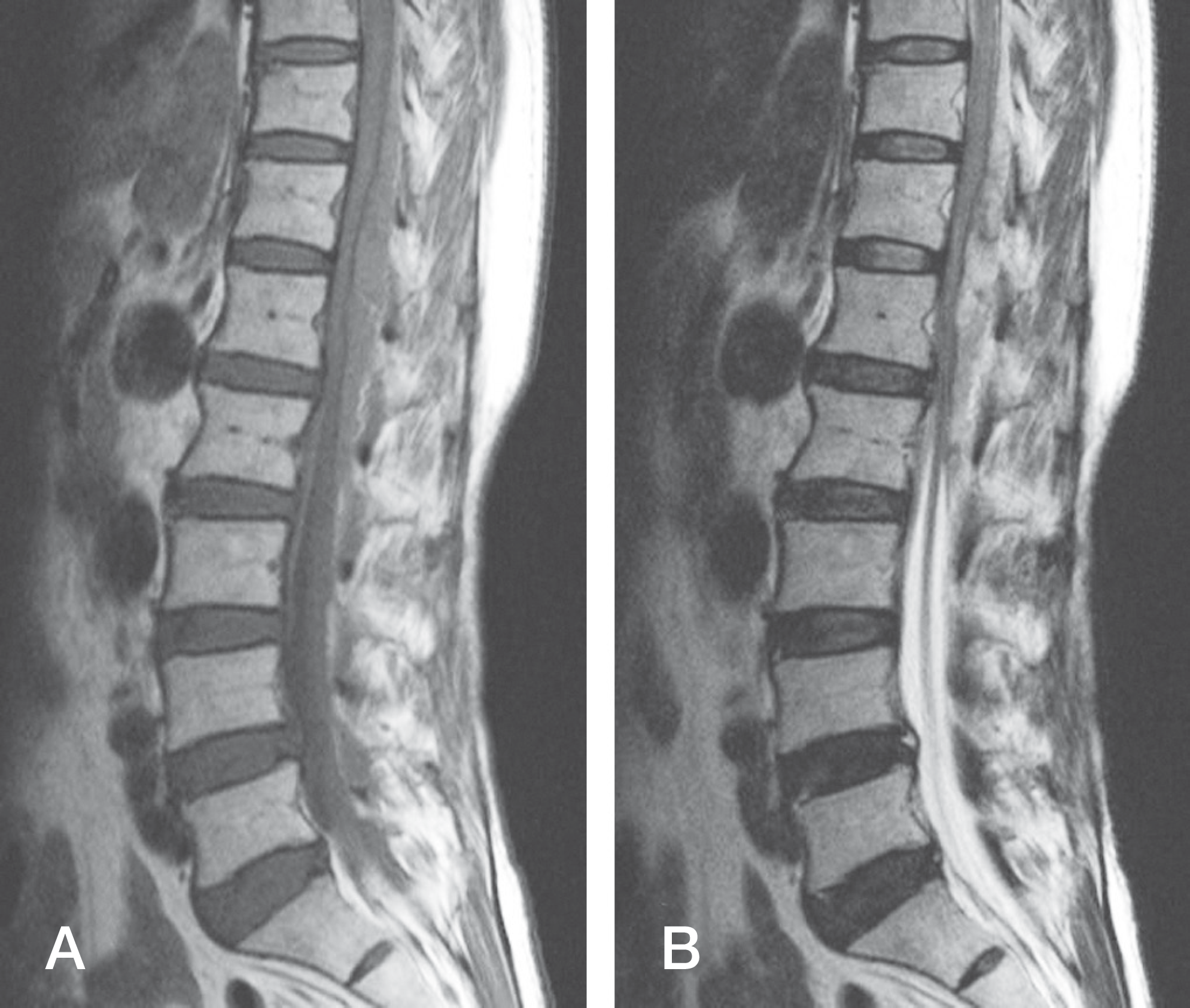Abstract
Objectives
To explore the risk factors and the factors associated with the neurological improvement after operation in the spontaneous spinal epidural hematoma.
Summary of Literature Review
The cause of the spontaneous spinal epidural hematoma is unknown. The objective risk and prognostic factors are still controversial.
Materials and Methods
From January 2006 to December 2014, a total of 12 patients with spontaneous epidural hematoma were evaluated. The risk and prognostic factors analyzed were sex, age, underlying diseases, medications, neurologic status, level and extent of hematoma, cord edema, and interval from onset to surgery. We analyzed the correlation between each factor and neurologic recovery. The neurologic status was analyzed using the American Spinal Injury Association impairment scale (AIS) at the first and the last neurologic examination.
Results
The average age of the patients was 68.6 years. Seven patients were treated with anticoagulation therapy, and two were advised to switch to a healthier diet. The initial neurologic status of the patients was AIS A in 2 cases, B in 5 cases, C in 4 cases, D in 1 case, and in two patients, cord edema was revealed on magnetic resonance imaging (MRI). The interval of time from onset to surgery was less than 24 hours in 6 cases, 24–48 hours in 4 cases, and more than 48 hours in 2 cases.
Conclusions
The prognostic factors associated with spontaneous spinal epidural hematoma were found to be initial neurologic status, cord edema on MRI, and interval from onset to surgery. We found no correlation between anticoagulation therapy or healthy diet and spontaneous spinal epidural hematoma, but anticoagulation therapy cannot be excluded as a risk factor.
Go to : 
REFERENCES
2. Liu Z, Jiao Q, Xu J, et al. Spontaneous spinal epidural hematoma: analysis of 23 cases. Surg Neurol. 2008; 69:253–60.

3. Braun P, Kazmi K, Nogues-Melendez P, et al. MRI findings in spinal subdural and epidural hematomas. Eur J Radiol. 2007; 64:119–25.

4. Kato S, Seki H, Koshu K. Acute cervical spinal hematoma with spontaneous resolution. Neurol Med Chir(TOKYO). 1994; 34:23–6.
5. Beatty RM, Winston KR. Spontaneous cervical epidural hematoma - A consideration of etiology. J Neuro Surg. 1984; 61:143–8.
6. Groen RJ, Ponssen H. The spontaneous spinal epidural hematoma - A study of the etiology. J Neurol Sci. 1990; 98:121–38.
7. Bruyn GW, Bosma NJ. Spinal extradural hematoma.(in Vinken PJ, Bruyn GW eds. Handbook of clinical neurology. Amsterdam North Holland publisher;1982. 1-30.).
8. Calliauw L, Ohara M, Martens F. Spinal epidural hematoma without lesion of the spine. Clin Neurol Neurosurg. 1988; 90:131–6.

9. Harik SI, Raichle ME, Reis DJ. Spontaneously remitting spinal epidural hematoma in a patient on anticoagulants. N Engl J Med. 1971; 284:1355–7.

10. Zhong W, Chen H, You C, et al. Spontaneous spinal epidural hematoma. J Clin Neurosci. 2011; 18(11):1490–4.

11. Krolick MA, Cintron GB. Spinal epidural hematoma causing cord compression after tissue plasminogen activator and heparin therapy. South Med J. 1991; 84:670–1.
12. Locke GE, Giorgio AJ, Biggers SI, et al. Acute spinal epidural hematoma secondary to aspirin induced prolonged bleeding. Surg Neurol. 1976; 5:293–6.
13. Bordia A. Effect of garlic on human platelet aggregation in vitro arun bordia. Atherosclerosis. 1978; 30:355–60.

14. Goodnight SH Jr, Harris WS, Connor WE. The effects of dietary omega 3 fatty acids on platelet composition and function in man: a prospective. controlled study. 1981; 58:880–5.
15. Rothfus WE, Chedid MK, Deeb ZL, et al. MR imaging in the diagnosis of spontaneous spinal epidural hematoma. J Comput Assist Tomogr. 1987; 11:851–4.
16. D'angelo V, Bizzozero L, Talamonti G, et al. Value of magnetic resonance imaging in spontaneous extradural spinal hematoma due to vascular malformation - case report. Surg Neurol. 1990; 34:343–4.
17. Avrahami E, Tadmor R, Ram Z, et al. MR demonstration of spontaneous acute epidural hematom of the thoracic spine. Neuroradiology. 1989; 31:89–92.
18. Shin JJ, Kuh SU, Cho YE. Surgical management of spontaneous spinal epidural hematomas. Eur Spine J. 2006; 15:998–1004.
19. Wagner S, Forsting M, Hacke W. Spontaneous resolution of a large spinal epidural hematoma - case report. Neurosurgery. 1996; 38:816–8.
20. Fukui MB, Swarnkar AS, Williams RL. Acute spontaneous spinal epidural hematomas. AJNR Am J Neuroradiol. 1999; 20:1365–72.
21. Boukobza M, Guichard JP, Boissonet M, et al. Spinal epidural haematoma - report of 11 cases and review of literature. Neuroradiology. 1994; 36:456–9.
22. Rahman K. Effects of garlic on platelet biochemistry and physiology. Mol Nutr Food Res. 2007; 51:1335–44.

23. Chen JH, Chen HI, Wang JS, et al. Effects of Welsh on-ion extracts on human platelet function in vitro. Lfe Sci. 2000; 66:1571–9.

24. McEwun BJ, Morel-kopp MC, Tofler GH, et al. The effect of omega-3 polyunsaturated fatty acids on fibrin and thrombin generation in healthy subjects and subjects with cardiovascular disease. Semin Thromb Hemost. 2015; 41:315–22.

25. Maynard FM Jr, Bracken MB, Creasey G, et al. International standards for neurological and functional classification of spinal cord Injury. American Spinal Cord Injury As sociation. Spinal Cord. 1997. 35:266–74.
Go to : 
 | Fig. 1.Sagittal MRI obtained from a 67-year-old woman suffering from sudden onset back pain and neurologic deficiency (AIS Grade D). There was no history of underlying disease or any medication. (A) A sagittal T1-weighted image shows a fusiform longitudinal epidural mass extending from T10 to L2, compressing the spinal cord, isointense with the spinal cord. (B) A sagittal T2-weighted image reveals hyperintensity. |




 PDF
PDF ePub
ePub Citation
Citation Print
Print


 XML Download
XML Download